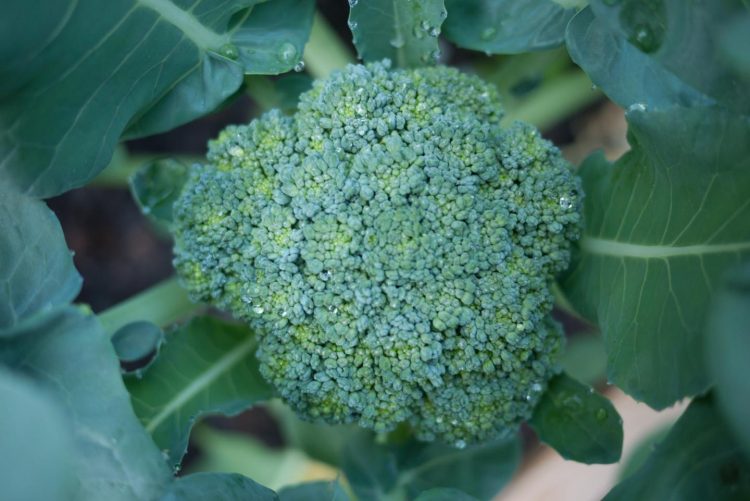Ammonium nitrogen input increases the synthesis of anticarcinogenic compounds in broccoli

Ammonium nutrition could increase the concentration of anti-oxidants and anticarcinogens in broccoli. Credit: Nate Steiner
Plants need nitrogen to grow, and intensive agriculture requires the input of nitrogen compounds. However, classical, nitrate-based fertilization is responsible for considerable environmental problems, such as the contamination of surface and underground water due to nitrate leaching, and the emission of greenhouse gases, owing to the effect of the micro-organisms in the soil that use the nitrate and produce nitrous oxide, a significant greenhouse gas.
In order to alleviate these problems, “an attempt is being made to encourage a different type of fertilizer treatment, and one of them is the use of ammonia together with nitrification inhibitors. The inhibitors cause this ammonia to be in the soil for longer and this helps to mitigate nitrate leaching and also nitrous oxide emissions,” explained Daniel Marino, researcher in the UPV/EHU's NUMAPS research group, which has conducted this study in collaboration with Dr Pedro Aparicio-Tejo of the UPN/NUP-Public University of Navarre. Yet this source of nitrogen has a special feature: “it can be toxic for plants and lead to reduced growth than when nitrate is used. In our group we are studying the tolerance and sensitivity of different plants to this source of nitrogen”. Seeking to go further into this subject, they went on to study the proteome of a model plant, Arabidopsis thaliana. “Without focussing on any protein in particular, we decided to see what differences were displayed by this plant within the synthesised proteins as a whole when ammonium or nitric fertilizers are applied,” said Daniel Marino.
The same results in edible plants
When studying the type and quantity of proteins accumulated in the plants with each type of nutrition, “what seemed most interesting to us is that there were some proteins related to the metabolism of glucosinolates which accumulate in a greater quantity in plants receiving an ammonium input,” stressed the researcher. In general, glucosinolates have two properties: they are natural insecticides and one of them in particular, glucoraphanin, has anticarcinogenic properties.
Given that the experiments had been conducted using the plant Arabidopsis thaliana, a model plant widely used in research but of no commercial interest, they decided to repeat the experiment, “but this time with broccoli plants. Although we did not manage to study the glucosinolate content in the part of the broccoli of greatest food interest, which is the flower, we saw that the leaves of the young plants accumulated a greater quantity of glucoraphanin when we added the source of nitrogen by means of ammonium than when we did so using nitrate,” explained Marino.
In view of these results, the research group is continuing to work on this aspect and they have even been in contact with several companies that could be interested in them. So in order to pursue their possible commercial application “we carried out field experiments where the system is much more complex, due, among other things, to the micro-organisms in the soil that also use ammonium as a source of nitrogen. So in the field experiments we will also be interested in analysing the glucosinolate content in the broccoli inflorescence, the part of the plant that is consumed most. On the other hand, from a more fundamental point of view, we are also interested in knowing the effect that the glucosinolates could have on the ammonium tolerance of the plant itself,” he explained.
###
Additional information
The biologist Daniel Marino-Bilbao, an Ikerbasque Research Fellow at the UPV/EHU, is a member of the research group NUMAPS (Nutrition Management in Plant and Soil), led by Carmen González-Murua, of the department of Plant Biology and Ecology in the UPV/EHU's Faculty of Science and Technology.
Bibliographical reference
Marino D, Ariz I, Lasa B, Santamaría E, Fernández-Irigoyen J, González-Murua C, Aparicio-Tejo P (2016) Quantitative proteomics reveals the importance of nitrogen source to control glucosinolate metabolism in Arabidopsis thaliana and Brassica oleracea. Journal of Experimental Botany 67: 3313-3323.
Media Contact
All latest news from the category: Agricultural and Forestry Science
Newest articles

An Endless Loop: How Some Bacteria Evolve Along With the Seasons
The longest natural metagenome time series ever collected, with microbes, reveals a startling evolutionary pattern on repeat. A Microbial “Groundhog Year” in Lake Mendota Like Bill Murray in the movie…

Witness Groundbreaking Research on Achilles Tendon Recovery
Achilles tendon injuries are common but challenging to monitor during recovery due to the limitations of current imaging techniques. Researchers, led by Associate Professor Zeng Nan from the International Graduate…

Why Prevention Is Better Than Cure—A Novel Approach to Infectious Disease Outbreaks
Researchers have come up with a new way to identify more infectious variants of viruses or bacteria that start spreading in humans – including those causing flu, COVID, whooping cough…



